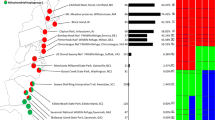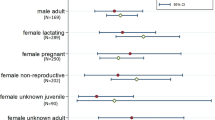Abstract
Birds often carry ticks infected with Borrelia burgdorferi sensu lato 1 — the spirochaete that causes Lyme disease — but their role as possible hosts and amplifiers for this illness has long been discounted. We find, however, that migratory birds are able to carry Lyme disease as a latent infection for several months, and that this infection can be reactivated and passed on to ticks as a result of migratory restlessness. Our results indicate that migratory birds may be efficient long-distance carriers of this pathogen.
This is a preview of subscription content, access via your institution
Access options
Subscribe to this journal
Receive 51 print issues and online access
$199.00 per year
only $3.90 per issue
Buy this article
- Purchase on Springer Link
- Instant access to full article PDF
Prices may be subject to local taxes which are calculated during checkout

JÖRGEN WIKLUND

Similar content being viewed by others
References
Olsen, B., Jaenson, T. G. T. & Bergström, S. Appl. Environ. Microbiol. 61 , 3082–3087 (1995).
Råberg, L., Grahn, M., Hasselquist, D. & Svensson, E. Proc. R. Soc. Lond. B 265, 1637–1641 (1998).
Apanius, V. in Stress and Behaviour (eds Møller, A. P., Milinski, M. & Slater, P. J. B.) 133–153 (Academic, San Diego, 1998).
Besedovsky, H. O. & del Rey, A. Endocr. Rev. 17, 64–102 (1996).
Mackowiak, P. A. Rev. Infect. Dis. 6, 649–668 (1984).
Holberton, R. L., Parrish, J. D. & Wingfield, J. C. Auk 113, 558– 564 (1996).
Alerstam, T. Bird Migration (Cambridge Univ. Press, 1990).
Barbour, A. G. Yale J. Biol. Med. 57, 521–525 (1984).
Welty, J. C. & Baptista, L. in The Life of Birds 119–141 (Saunders College Publishing, New York, 1988).
Hubálek, Z., Halouzka, J. & Heroldová, M. J. Med. Microbiol. 47, 929– 932 (1998).
Humair, P. F. et al. Zentralbl. Bakteriol. 287, 521– 538 (1998).
Kurtenbach, K. et al. Appl. Environ. Microbiol. 64, 1169– 1174 (1998).
Author information
Authors and Affiliations
Corresponding author
Rights and permissions
About this article
Cite this article
Gylfe, Å., Bergström, S., Lundstróm, J. et al. Reactivation of Borrelia infection in birds. Nature 403, 724–725 (2000). https://doi.org/10.1038/35001663
Issue Date:
DOI: https://doi.org/10.1038/35001663
This article is cited by
-
Effects of stress exposure in captivity on physiology and infection in avian hosts: no evidence of increased Borrelia burgdorferi s.l. infectivity to vector ticks
Microbial Ecology (2022)
-
Migrant birds and mammals live faster than residents
Nature Communications (2020)
-
Getting under the birds’ skin: tissue tropism of Borrelia burgdorferi s.l. in naturally and experimentally infected avian hosts
Microbial Ecology (2020)
-
Control of Lyme borreliosis and other Ixodes ricinus-borne diseases
Parasites & Vectors (2018)
-
Do avian blood parasites influence hypoxia physiology in a high elevation environment?
BMC Ecology (2018)
Comments
By submitting a comment you agree to abide by our Terms and Community Guidelines. If you find something abusive or that does not comply with our terms or guidelines please flag it as inappropriate.



